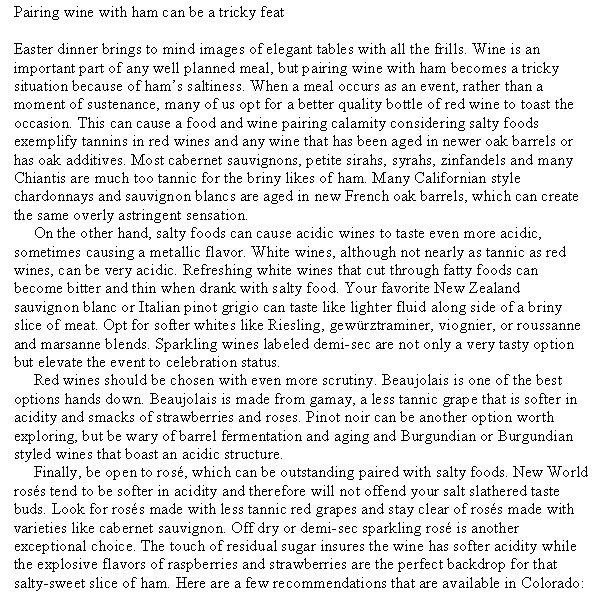|
|

Kesseler Estate Riesling $11
Eifel Cuvee A Riesling $24
Fritz Allendorf Pinot Rosé $10
Durheimer Portugeiser Rosé $15
Latour Beaujolais Chameroy Cru $10
Duboeuf Beaujolais Fleurie $13
Rosenblum Roussanne $18
Yalumba Y Viognier $10
Beckman Marsanne $16
Thomas Fogarty Gewürz $13
Articles are property of Brenda Francis and are not to be reproduced in any way without written consent from Brenda Francis.
Pairing wine with ham can be a tricky feat
Easter dinner brings to mind images of elegant tables with all the frills. Wine is an important part of any well planned meal, but pairing wine with ham becomes a tricky situation because of ham's saltiness. When a meal occurs as an event, rather than a moment of sustenance, many of us opt for a better quality bottle of red wine to toast the occasion. This can cause a food and wine pairing calamity considering salty foods exemplify tannins in red wines and any wine that has been aged in newer oak barrels or has oak additives. Most cabernet sauvignons, petite sirahs, syrahs, zinfandels and many Chiantis are much too tannic for the briny likes of ham. Many Californian style chardonnays and sauvignon blancs are aged in new French oak barrels, which can create the same overly astringent sensation.
On the other hand, salty foods can cause acidic wines to taste even more acidic, sometimes causing a metallic flavor. White wines, although not nearly as tannic as red wines, can be very acidic. Refreshing white wines that cut through fatty foods can become bitter and thin when drank with salty food. Your favorite New Zealand sauvignon blanc or Italian pinot grigio can taste like lighter fluid along side of a briny slice of meat. Opt for softer whites like Riesling, gewürztraminer, viognier, or roussanne and marsanne blends. Sparkling wines labeled demi-sec are not only a very tasty option but elevate the event to celebration status.
Red wines should be chosen with even more scrutiny. Beaujolais is one of the best options hands down. Beaujolais is made from gamay, a less tannic grape that is softer in acidity and smacks of strawberries and roses. Pinot noir can be another option worth exploring, but be wary of barrel fermentation and aging and Burgundian or Burgundian styled wines that boast an acidic structure.
Finally, be open to rosé, which can be outstanding paired with salty foods. New World rosés tend to be softer in acidity and therefore will not offend your salt slathered taste buds. Look for rosés made with less tannic red grapes and stay clear of rosés made with varieties like cabernet sauvignon. Off dry or demi-sec sparkling rosé is another exceptional choice. The touch of residual sugar insures the wine has softer acidity while the explosive flavors of raspberries and strawberries are the perfect backdrop for that salty-sweet slice of ham. Here are a few recommendations that are available in Colorado:
Kesseler Estate Riesling $11
Eifel Cuvee A Riesling $24
Fritz Allendorf Pinot Rosé $10
Durheimer Portugeiser Rosé $15
Latour Beaujolais Chameroy Cru $10
Duboeuf Beaujolais Fleurie $13
Rosenblum Roussanne $18
Yalumba Y Viognier $10
Beckman Marsanne $16
Thomas Fogarty Gewürz $13
|




